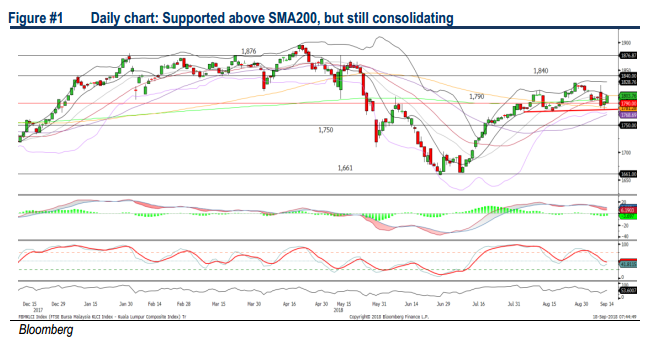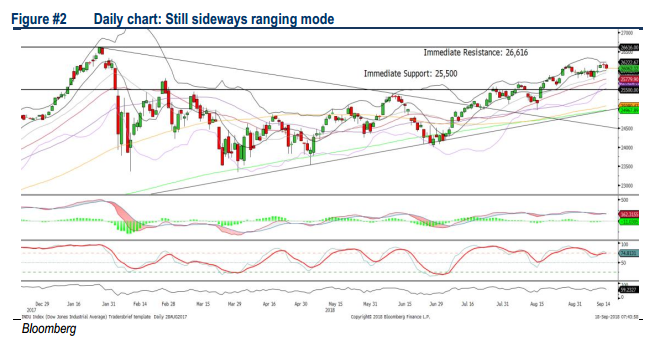Traders Brief - Likely to Trap in Consolidation Mode
HLInvest
Publish date: Tue, 18 Sep 2018, 04:34 PM
MARKET REVIEW
Asia’s markets were mostly negative as the trade tensions between the US-China remained in focus; President Trump may impose 10% tariffs on USD200bn on Chinese goods, despite US attempted to reopen trade discussions with Beijing. The Nikkei 225 increased 1.20%, but Shanghai Composite Index and Hang Seng Index dived 1.11% and 1.30%.
Following the positive foreign inflows last Thursday and Friday, the FBM KLCI jumped significantly higher on Friday led by banking heavyweights and telco stocks. We noticed broader market was more bullish as advancers led decliners by a ratio of nearly 2-to-1. Also, market traded volumes rose 12.6% to 2.68bn shares, worth RM2.48bn.
Wall Street took a breather after being traded higher last week as President Trump commented that he may reveal some announcement on trade after market hours as he was not satisfied with the trade discussions with China. Also, technology giants such as Apple and semiconductor-related stocks ended lower amid fears that they may get hit with tariffs.
TECHNICAL OUTLOOK: KLCI
The FBM KLCI fluctuated around the SMA200 last week and ended above the SMA200 on Friday. The MACD Histogram has recovered marginally, despite the MACD Line continues to hover below Signal Line. Also, both the RSI and Stochastic oscillators are recovering above 50; suggesting that the positive momentum could be picking up. Hence, short term follow through buying interest could be expected towards the upper band of the consolidation phase around 1,828, while the support will be pegged around 1,797, followed by 1,777.

Negative sentiment from Wall Street and the trade concerns may spillover towards stocks on the local front and the FBM KLCI may continue to trade within the range between 1,777-1,828. Nevertheless, the positive inflows over the past two trading days may cushion the downside risk over the near term. Also, traders may focus on export-oriented and O&G related stocks amid weaker ringgit tone and firmer crude oil prices.
TECHNICAL OUTLOOK: DOW JONES
The Dow snapped a 5-day winning streak, but maintained its move above 26,000 psychological level. The MACD Indicator is still positive, but the RSI and Stochastic oscillators are weakening. Hence we expect sideways consolidation phase between the 25,800-26,200 levels over the near term.

We expect the trade tensions to persist over the near term as President Trump remains stern and bold on his statements on the trade issues. Hence, we anticipate that Wall Street could go nto a consolidation phase with heightened volatility moving forward. Also, corporates that have heavy business exposure in China may get hit should there be any further implementations of trade tariffs.
Source: Hong Leong Investment Bank Research - 18 Sept 2018





















